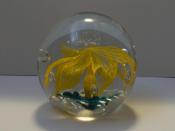In the haunting novel 1984, George Orwell effectively warns his readers about the dangers of totalitarianism and the horrific measures governments are willing to take in order to sustain power over its people. In order to create the desired effect and instill terror among his readers, Orwell wove a powerful story that can be lauded as a literary masterpiece. His work abounds in literary devices that serve to enrich the text and give the storyline more depth. Of these devices, symbolism is perhaps the most effectively employed. Orwell utilizes a variety of different symbols in order to carry out different functions such as the foreshadowing of different events, development of the setting, creation of the dreary mood, unveiling of the true natures of the characters, introduction to and reinforcement of themes, and so forth. He uses a vast array of symbols such as an old diary, a supposedly heretical book, an idyllic landscape known as the 'Golden Country', a painting of a church, the technologically advanced television and surveillance tool known as the 'telescreen', a singing thrush, and most importantly, a glass paperweight.
The paperweight is the single most significant symbol in the story because unlike the other symbols, it embodies all the literary aspects of the novel and combines the ideas and functions of all the other symbols.
Every symbol mentioned in the text has its significance and plays some sort of literary role. The old diary Winston writes in introduces the conflict of the novel since it reflects Winston's inner desire to search for truth and verify his sanity. The diary also characterizes Winston's rebellious nature and gives more depth to his character since it reflects on his inner most thoughts. Goldstein's book represents false hope and the ideas expressed in it reinforce the theme of totalitarianism. The...


